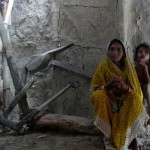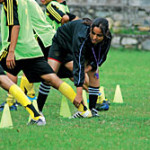A New Day in Nepal?

Maoist combatants at a function to hand over command at the Shaktikhor Maoist cantonment in Chitwan, Nepal in January of this year (AP from thehindu.com)
On Tuesday, Nepal cleared its last remaining minefield, nearly five years after the country’s long civil war. The removal was one of the main terms of the 2006 peace accord. In other areas, however, the peace process has stalled, since the Comprehensive Peace Agreement (CPA) was begun in 2008. The Constituent Assembly was elected at that time, with a mandate to draft a new constitution within two years. But with no party holding the necessary 2/3’s majority, a coalition government was formed and consensus has proved difficult to reach.
May 28th marked the 2nd time the deadline to have the constitution ratified, passed without resolution. Nepal’s Prime Minister, Jhalanath Khanal stepped down as part of the deal to extend the deadline. One of the biggest challenges to find common ground on, is the issue of integrating former Maoist fighters into Nepal’s security forces.
We recently had two visitors from our Nepal Office who were able to speak about Nepal’s future regarding reintegration, Sujata our Community Peacebuilding Manager and Prem our Youth Program Coordinator.
“Although peace is signed at the national level, war is fought on the ground, therefore, peacebuilding must also happen on the ground.” ~Sujata
As part of the CPA, Maoist agreed to confine their fighters to seven main cantonment sites and 21 satellite camps across the country so the disarmament, demobilization and reintegration (DDR) process could be coordinated and agreed upon. So far, Sujata jokes, the process has been much more R than D&D. The UNMIN (UN Mission in Nepal) verified over 19,000 Maoists fighters and registered over 30,000 ex-combatants but fewer than 4,000 weapons have been registered.
Women and child soldiers pose a particular problem. Both are underrepresented in the cantonments. A fair estimation of the number of women actively involved in fighting, Sujata says, is 25-30% but the number in the cantonments is less than 20%.
Part of the reason, is face-saving. The extent to which Maoists used children and women soldiers has been downplayed and many have been disqualified from receiving reintegration packages. Those combatants disqualified from the rehabilitation and reintegration processes, either for being under 18 or for enlisting after the peace agreement, have already been discharged from the cantonments. They often return to their homes with little support and meet animosity when they arrive.
At war’s end, many female soldiers had different priorities than their male counterparts. Many felt the need to return to families or were worried about their marital prospects after having spent so much time unchaperoned in the company of men. Women played an active role in the civil war and in a short span of time, Nepal went from a country where women could not wear pants to one where they were bearing arms. Despite its ravages, the war had some positive impact on women; for some it offered freedom from poverty and tradition. It was empowering in many ways, Sujata says, and the country is still adjusting to the changes that means for Nepali society.
For women soldiers, implementation, not policy is the problem; many are simply not aware of their rights regarding the reintegration process.
Former child soldiers are faring better, in the sense that there are specific programs working towards their reintegration.
“In Nepal, war has a young face,” ~Sujata
UNMIN’s role was limited to verifying the fighters and identifying weapons, and Search has stepped in to lead the youth and peacebuilding component of the reintegration process.
During the war children as young as 8 and 9 were involved in the fighting. Now the majority of the former child soldiers are around 18-24 years old, have spent a substantial amount of their youth in combat and are often ill-prepared for much else. Creating sustainable livelihoods is a major challenge.
Issues of class and anger at marginalization by elites was a driving force in the Maoist philosophy. Many schools were destroyed during the war, because of they were seen as a symbol of the classism that elevated some and denigrated others, Prem says. Now former combatants are enrolling in the same schools they had a hand in destroying.
There is distrust and prejudice on both sides, from the ex-combatants and from the communities to which they return. Search has utilized both media and football to start dialogues and cooperation in divided communities. Radio has been helpful in creating a platform for youth to speak and feel heard. Our new soap opera, Hamro Team focuses on diverse voices as much as it does national unity.
Maoists deeply believe Mao Zedong’s statement that “political power grows out of the barrel of a gun,” and one of the major challenges of our work, says Prem, is showing former child soldiers that they can be empowered without their guns. However, Nepal remains polarized at all levels of society, from the schools to the politicians. And this is increasing.
For centuries Nepali identity was based around the majority Hindu culture, to the marginalization of the country’s numerous minorities. The tenuous unity was broken by the civil war and lack of a Nepali national identity has been one of the conflict’s lasting results. Filling that void, political parties form identity-based groups. The style of identity-based politics has become more prevalent after the peace agreement, Prem says. The process of reintegration involves more than returning people to their communities. Those communities themselves have changed and been changed by the same events and issues which sent others to war. In reintegrating former rebels into public life on a large scale, Nepal must ask itself what kind of communities it wants, what kind of state?
How do you think Nepal will integrate Maoist soldiers into the national security forces? How do you think the reintegration of female soldiers will change the role of women in Nepal?
Learn more about our program in Nepal and connect with Search online.








